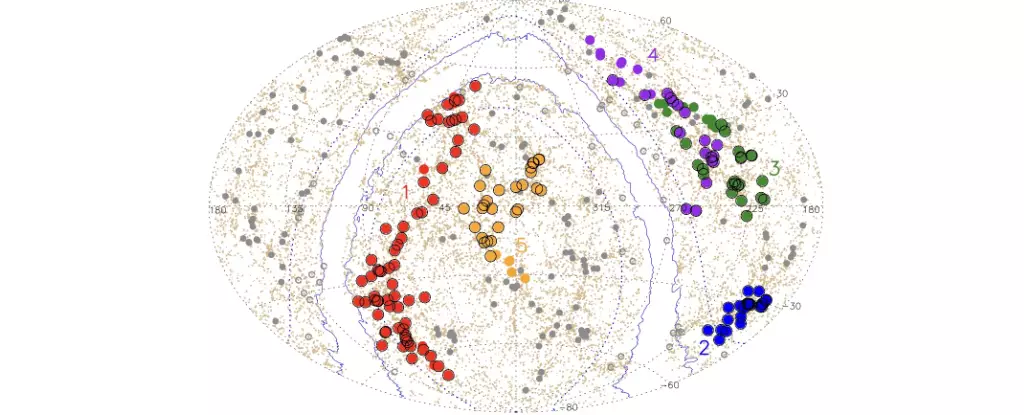Astrophysics, at its core, seeks to decode the intricate machinations of the universe. To achieve this goal, understanding the massive structures that shape cosmological dynamics is paramount. One of the most significant discoveries affecting our comprehension of the cosmos is the Quipu superstructure. This behemoth, weighing in at an astonishing 200 quadrillion solar masses, has far-reaching implications that prompt deeper investigations into cosmic evolution and the very models that guide our understanding of the universe.
When encountering astronomical figures as staggering as 200 quadrillion, it becomes clear that our conventional understanding of numbers must adapt. Such mass challenges our comprehension of gravitational forces and interactions that transcend our earthly experiences. Quipu’s enormity is not solely an impressive fact; it fundamentally alters cosmic mechanics. With a span exceeding 400 megaparsecs (more than 1.3 billion light-years), it is hard to fathom how a structure of this size would not influence its cosmic neighbors profoundly. The researchers advocating for the importance of superstructures like Quipu strive to illustrate that they exert measurable impacts that can transform cosmological datasets.
The necessity of recognizing these massive structures becomes evident in the context of cosmological measurements. According to the authors of recent research published in “Astronomy and Astrophysics”—led by Hans Bohringer from the Max Planck Institute—”For a precise determination of cosmological parameters, we need to understand the effects of the local large-scale structure of the Universe on the measurements.” This highlights the interdependent nature of these structures and measurements, underscoring that our understanding of universal phenomena hinges on our grasp of superstructures.
Quipu’s astounding size allows it to harbor a significant population of celestial bodies. The research indicates that it contains a staggering 45% of the galaxy clusters and 30% of the total galaxies, meaning that these superstructures are critical to our understanding of galactic evolution. The analysis that identified Quipu as the largest structure allows us to consider how mass concentrations create gravitational effects that ripple throughout the cosmos.
Superstructures are not singleton anomalies but parts of an organized cosmic web that includes other similar massive clusters. The study identified four additional superstructures in the vicinity of Quipu, indicating a prevalent pattern that warrants further exploration. Utilizing X-ray observations from galaxy clusters, researchers capture the emissions produced by hot intracluster gas, allowing them to effectively trace mass distribution. This method provides critical insight into the cosmic backdrop against which galaxies form, evolve, and interact.
The repercussions of Quipu’s existence extend beyond its immediate vicinity. The gravitational influence exerted by superstructures can significantly alter cosmological observations, specifically those pertaining to the Cosmic Microwave Background (CMB). The authors note that the immense mass of superstructures can distort this foundational relic from the Big Bang, leading to fluctuations that challenge our measurements. Fluctuations within the CMB, generated by the Integrated Sachs-Wolfe (ISW) effect, complicate efforts at refining our understanding of cosmic origins.
Additionally, the Hubble constant—critical in determining the rate of the universe’s expansion—can be significantly swayed by these extensive structures. As galaxies navigate the cosmos, their local velocities often integrate with the overarching cosmic expansion. This layering of velocities poses challenges to precise measurements, making it essential to discern these peculiar motions from standard expansion dynamics. The superstructures create a situation where expansive forces and local gravitational effects interplay, demanding intricate modeling and analysis to clarify.
Intriguingly, the future of these superstructures is not one of permanence. Bohringer’s research suggests that Quipu and its counterparts are not immutable fixtures; they will eventually fragment into smaller units. This dynamism indicates a complex and evolving universe where large-scale structures may emerge, destabilize, and ultimately transition into new configurations over cosmic timescales.
The potential for superstructures to evolve, merge, or collapse adds a layer of complexity to our understanding of the cosmos. Future studies should focus on how these structures influence galactic populations and how galaxies adapt to changing environments within and around superstructures.
The discovery of Quipu not only signifies a remarkable achievement in observational astronomy but also entails a pressing invitation for more extensive exploration. The intricate relationships between superstructures and their impact on cosmological parameters form a crucial frontier in modern astrophysics. Understanding these relationships is vital for shaping refined cosmological models and improving our perceptions of the universe. Just as the Incan quipu held woven knowledge, so too does Quipu—the superstructure—serve as a pivotal thread in the vast tapestry of the universe awaiting further exploration and understanding.


Leave a Reply